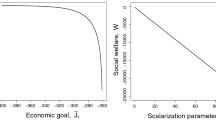Abstract
We analyze a macroeconomic model with intergenerational equity considerations and spatial spillovers, which gives rise to a multicriteria optimization problem. Intergenerational equity requires to add in the definition of social welfare a long run sustainability criterion to the traditional discounted utilitarian criterion. The spatial structure allows for the possibility of heterogeneiity and spatial diffusion implies that all locations within the spatial domain are interconnected via spatial spillovers. We rely on different techniques (scalarization, \(\epsilon \)-constraint method and goal programming) to analyze such a spatial multicriteria problem, relying on numerical approaches to illustrate the nature of the trade-off between the discounted utilitarian and the sustainability criteria.




Similar content being viewed by others
References
André, F. J., Cardenete, M. A., & Romero, C. (2009). A goal programming approach for a joint design of macroeconomic and environmental policies: A methodological proposal and an application to the Spanish economy. Environmental Management, 43, 888–898.
Aouni, B., Colapinto, C., & La Torre, D. (2014). Financial portfolio management through the goal programming model: Current state-of-the-art. European Journal of Operational Research, 234, 536–545.
Arrow, K., Dasgupta, P., Goulder, L., Daily, G., Ehrlich, P., Heal, G., et al. (2004). Are we consuming too much? Journal of Economic Perspectives, 18, 147–172.
Boucekkine, R., Camacho, C., & Fabbri, G. (2013a). On the optimal control of some parabolic differential equations arising in economics. Serdica Mathematical Journal, 39, 331–354.
Boucekkine, R., Camacho, C., & Fabbri, G. (2013b). Spatial dynamics and convergence: The spatial AK model. Journal of Economic Theory, 148, 2719–2736.
Boucekkine, R., Camacho, C., & Zou, B. (2009). Bridging the gap between growth theory and economic geography: The spatial Ramsey model. Macroeconomic Dynamics, 13, 20–45.
Brito, P. (2004). The dynamics of growth and distribution in a spatially heterogeneous world. Lisbon: UECE-ISEG: Technical University of Lisbon.
Camacho, C., & Zou, B. (2004). The spatial Solow model. Economics Bulletin, 18, 1–11.
Camacho, C., Zou, B., & Briani, M. (2008). On the dynamics of capital accumulation across space. European Journal of Operational Research, 186(2), 451–465.
Charnes, A., & Cooper, W. W. (1961). Management models and industrial applications of linear programming. New York: Wiley.
Charnes, A., Cooper, W. W., & Ferguson, R. O. (1955). Optimal estimation of executive compensation by linear programming. Management Science, 2, 138–151.
Chinchilnisky, G. (1997). What is sustainable development? Land Economics, 73, 476–491.
Chinchilnisky, G., Heal, G., & Beltratti, A. (1995). The green golden rule. Economics Letters, 49, 174–179.
Colapinto, C., Jayaraman, R., & Marsiglio, S. (2017b). Multi-criteria decision analysis with goal programming in engineering, management and social sciences. Annals of Operations Research, 251, 7–40.
Colapinto, C., Liuzzi, D., & Marsiglio, S. (2017a). Sustainability and intertemporal equity: A multicriteria approach. Annals of Operations Research, 251, 271–284.
Craven, B. D. (2009). Pontryagin principle with a PDE: a unified approach. In C. Pearce & E. Hunt (Eds.), Optimization. Springer optimization and its applications (Vol. 32). New York: Springer.
Heal, G. (2005). Intertemporal welfare economics and the environment. In K. G. Maler & J. R. Vincent (Eds.), Handbook of environmental economics (Vol. 3). Amsterdam: North-Holland.
Jayaraman, R., Colapinto, C., La Torre, D., & Malik, T. (2015). Multi-criteria model for sustainable development using goal programming applied to the United Arab Emirates. Energy Policy, 87, 447–454.
Krugman, P. (1991). Increasing returns and economic geography. Journal of Political Economy, 99, 483–499.
La Torre, D., Liuzzi, D., & Marsiglio, S. (2015). Pollution diffusion and abatement activities across space and over time. Mathematical Social Sciences, 78, 48–63.
La Torre, D., Liuzzi, D., & Marsiglio, S. (2017). Pollution control under uncertainty and sustainability concern. Environmental and Resource Economics, 67, 885–903.
La Torre, D., Liuzzi, D., & Marsiglio, S. (2019). Population and geography do matter for sustainable development. Environment and Development Economics, 24, 201–223.
La Torre, D., & Marsiglio, S. (2019). A note on optimal debt reduction policies. Macroeconomic Dynamics. https://doi.org/10.1017/S1365100519000014.
Le Kama, A. D. A. (2001). Sustainable growth, renewable resources and pollution. Journal of Economic Dynamics & Control, 25, 1911–1918.
Marsiglio, S., & La Torre, D. (2018). Economic growth and abatement activities in a stochastic environment: A multi-objective approach. Annals of Operations Research, 267, 321–334.
Marsiglio, S., & Privileggi, F. (2019). On the economic growth and environmental trade-off: A multi-objective analysis. Annals of Operations Research. https://doi.org/10.1007/s10479-019-03217-y.
Pezzey, J. C. V. (1997). Sustainability constraints versus optimality versus intertemporal concern, and axioms versus data. Land Economics, 73, 448–466.
Quah, D. T. (1996). Regional convergence clusters across Europe. European Economic Review, 40, 951–958.
Ramsey, F. (1928). A mathematical theory of saving. Economic Journal, 38, 543–559.
Sawaragi, Y., Nakayama, H., & Tanino, T. (1985). Theory of multiobjective optimization. New York: Academic Press, Inc.
Solow, R. M. (1956). A contribution to the theory of economic growth. Quarterly Journal of Economics, 70, 65–94.
Wolfe, D. A., & Gertler, M. S. (2004). Clusters from the inside and out: Local dynamics and global linkages. Urban Studies, 41, 1071–1093.
World Commission on Environment and Development. (1987). Our common future. Oxford: Oxford University Press.
Author information
Authors and Affiliations
Corresponding author
Additional information
Publisher's Note
Springer Nature remains neutral with regard to jurisdictional claims in published maps and institutional affiliations.
Rights and permissions
About this article
Cite this article
Kunze, H., La Torre, D. & Marsiglio, S. Sustainability and spatial spillovers in a multicriteria macroeconomic model. Ann Oper Res 311, 1067–1084 (2022). https://doi.org/10.1007/s10479-020-03814-2
Accepted:
Published:
Issue Date:
DOI: https://doi.org/10.1007/s10479-020-03814-2




